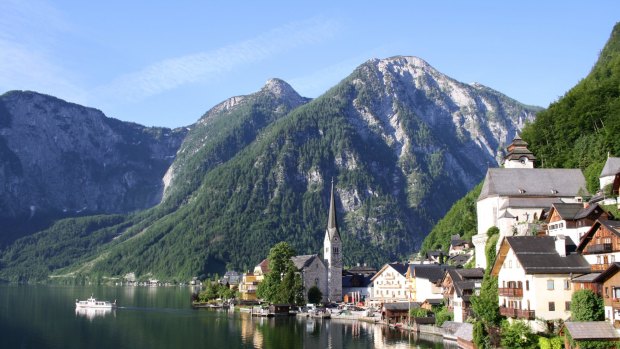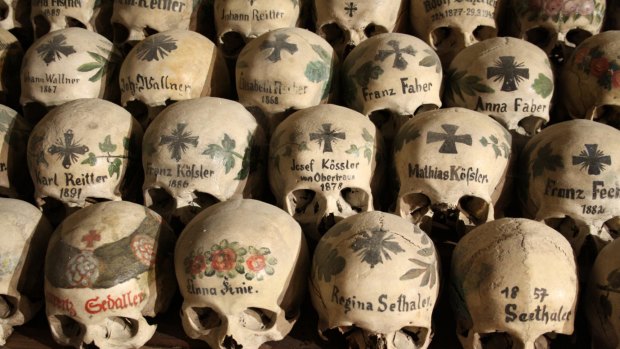This was published 10 years ago
Hallstatt, Austria: The most picturesque place to die
The Austrian village of Hallstatt is drop-dead gorgeous in more ways than one, writes Brian Johnston.

Hallstatt is possibly the oldest continuously inhabited village in Europe. Credit: Brian Johnston
I can't help thinking Hallstatt would be a fine place to die. My last sight would be of snowy mountains and a blue lake crosshatched by the wakes of paddling swans: a sneak peak at the heaven I'd be hoping shortly to enter. What's more, I'd be able to spend my eternal rest in a charnel house overlooking the pretty village. I could have my head cut off and my skull cleaned. Some buxom dirndl-clad villager would paint it with gentians and edelweiss and set it on a shelf, next to the skull of Anna Knie, perhaps, whose bony brow is rather jaunty with painted roses. Then I could grin for generations at surprised tourist faces peeking through the chapel's metal grilles.
Some 1200 former residents of Hallstatt have opted for such an eternal rest, admittedly mostly in the nineteenth century, though the last skull ended up here in 1995. The skulls are rather helpfully painted with the year of their owner's demise, and leg bones are piled beneath as tidily as Austrians stack firewood against their chalets.
Next door, the 800-year-old graveyard of the parish church squeezes between sky, mountain and lake. I can see why its inhabitants had to be moved on to even more compact accommodation. No surprise, perhaps, that Saint Barbara takes pride of place in the church; she's the patron saint of gravediggers.

The charnel house at the parish church in Hallstatt. Credit: Brian Johnston
I may be perverse, but the graveyard is my favourite place in Hallstatt. Its wrought-iron crosses and flower-packed graves are delightful, and its terrace provides the best view in town, which is saying something. The lake below is mirror-calm, muscular Alps rear and houses cascade geraniums. In the Salzkammergut region an hour southeast of Salzburg, saccharine lakeshore villages are everywhere, but Hallstatt takes kitschy beauty to its limits.
Besides, I like the way this place reminds me of death in that pointed, medieval sort of way. It suddenly cautions that I'd better not enjoy my strudel too much, because gluttony is a sin and – who knows? – today might be my last. Maybe I should dwell on a more modern message, and order some extra whipped cream. Carpe diem.
Hallstatt has been burying people for a long time; it's possibly the oldest continuously inhabited village in Europe. The town's museum exhibits artefacts unearthed from Neolithic grave sites. There are Iron Age graves at the entrance to its ancient salt mines; an audio guide explains their burial rituals. On a tour of the salt mine itself I hear about the 'Man in the Salt', a 2,500-year-old Celtic miner unearthed in 1734, marvellously preserved down to his hair and clothes.
When I'm chilled by the salt mines, I loiter on the sunny lakefront. Flat-bottomed boats drift and church bells clang. The village is a swallow's nest arrangement of pastel houses on the hillside. Shop signs are in Japanese, but the times have moved on: it's Koreans and Chinese that tramp through these days. Hallstatt is notable for having being cloned in the southern Chinese city of Huizhou as a giant theme park though, to my knowledge, the faux Hallstatt has no charnel house.
Pity the Japanese are too cash-strapped to come here these days. They might remind Chinese visitors of a thing or two, namely that there's something intrinsic to the beautiful that reminds of the transience of life, like the fluttering of cherry blossoms that appear so briefly and then are gone. You can't replicate beauty, and why would you try? Hallstatt isn't just a pretty picture. It's a remarkable place where humans have loved and died for 7000 years. Hedonists will pass through and snap photos, but philosophers will linger, and ponder life.
TRIP NOTES
MORE INFORMATION
GETTING THERE
Etihad flies to Abu Dhabi (14.5hr) and Munich (6hr 30min), a scenic three-hour drive from Hallstatt. Return economy fare from $1,596 from Melbourne and $1,976 from Sydney including taxes. Phone 1300 532 215, see etihad.com
GETTING AROUND
Leading Australian self-drive specialist DriveAway Holidays offers car hire at Munich airport from around $300 per week. Phone 1300 723 972, see driveaway.com.au
STAYING THERE
Heritage Hotel Hallstatt links three historic houses with considerable flair. No two rooms are the same; many have lake views. Rooms for two from $240 including service and taxes. Phone +43 6134 20036, see hotel-hallstatt.com
EATING THERE
Bräugasthof started as a brewery in 1472, retains a traditional atmosphere, and is the place for fresh lake fish. Phone +43 6134 20673, see brauhaus-lobisser.com
The writer travelled courtesy the Austrian National Tourist Office.
Sign up for the Traveller Deals newsletter
Get exclusive travel deals delivered straight to your inbox. Sign up now.